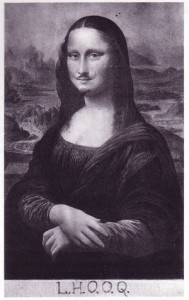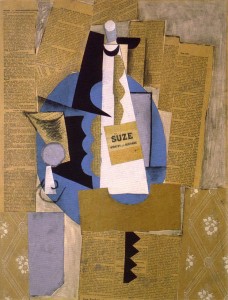But is it Art?
 I’m taking a few courses at U of T this fall, and one of them is Visual Studies. It’s interesting to see where the course fits into the continuum of art courses, especially since this is part of what was a Studio, not History program. But more to the point, it’ll be interesting to see how the course defines art, and where it fits into another continuum of old pretty stuff versus new weird stuff.
I’m taking a few courses at U of T this fall, and one of them is Visual Studies. It’s interesting to see where the course fits into the continuum of art courses, especially since this is part of what was a Studio, not History program. But more to the point, it’ll be interesting to see how the course defines art, and where it fits into another continuum of old pretty stuff versus new weird stuff.
Well, we started with a definition of Art. Not art mind you, but Art. Sure, they respect the term regarding the art of cooking and the art of motorcycle maintenance (for example) as referring to skills, discipline and so on. This usage is pretty old, and used to be applied in academic circles to all kinds of technical stuff that we wouldn’t call very artsy today. Yes, the Professor acknowledged the history of the word, but then brought us into the present.

She showed us a number of works of art, then asked us which were Art, and which were not. I won’t bore you with the details, but stuff like Leonardo’s Mona Lisa and the Sistine Chapel ceiling weren’t Art, though they are beautiful. Nope,if you’re looking for Art, look for Duchamp’s Mona Lisa with a mustache, Warhol’s can of Campbell’s soup, and (there he is again) Duchamp’s “fountain” urinal. Being (mostly) young students, we were not offended by this, but more intrigued by the nature of the lesson. Not Art? But we thought that was Art! How are you going to get out of this one, Prof?
Without going into details, I shall now give you the Art world’s opinion of what qualifies a work of Art:
- Its creative direction must come from the Artist, not from a patron. This is a reflection of the breakdown of the traditional patronage (the Church, royalty) of the past. This kills the Sistine Chapel, since Michelangelo didn’t want to do it. He preferred sculpture, but you don’t refuse your patron. This definition also came about as a result of the French and American revolutions, which exalted the power of the individual. All were now equal, but with equal chance to become starving artists.
- The piece must pass through the Art community, and be valued as a work of Art. This is a little circular, but goes to credentials, I suppose. It means that my Uncle Charlie can try to drag his 1948 Harley out of the garage and call it a work of Art, but unless the Art world agrees, it ain’t Art.
- The piece has to have no useful purpose. This requirement can be a little gray in some cases, but it prevents someone from putting a screwdriver on a pedestal and calling it art. Maybe it also explains why some artists make things that look just like the real thing, but out of an unexpected material, say, they might make an exact copy of a bathtub out of minty filling. A dinosaur made of chairs would have no useful purpose, though each chair might. This also means that many ancient artifacts are not Art, because they were made with a purpose: to direct religious ceremonies, or provide a focus during meditation.
I hope that makes sense. It doesn’t mean that all the old stuff is less beautiful, but I think it does open up the idea of Art to a lot of things previously thought to be weird or stupid. It makes it more interesting to discuss works of Art with regard to intention, context and so on.
 For example, picture a Picasso, such as the one at left, Glass and Bottle of Suze. We might be dulled to its impact, because we’ve seen so many parodies of the style, and we’ve seen everything that has come after (especially in graphic design), having been influenced by it. But if we look into the context of the time (1912), where Western paintings were all done using conventional, realistic perspective, that flattening the plane and unfolding objects was extremely radical. It’s also interesting to note that the camera was popularized around this time, freeing artists from making paintings that looked like photographs at some level.
For example, picture a Picasso, such as the one at left, Glass and Bottle of Suze. We might be dulled to its impact, because we’ve seen so many parodies of the style, and we’ve seen everything that has come after (especially in graphic design), having been influenced by it. But if we look into the context of the time (1912), where Western paintings were all done using conventional, realistic perspective, that flattening the plane and unfolding objects was extremely radical. It’s also interesting to note that the camera was popularized around this time, freeing artists from making paintings that looked like photographs at some level.
Here’s my point: by understanding this definition of Art and allowing ourselves to discuss it at a level beyond our idea of beauty, we can look at it as a series of historical, social and psychological documents, giving us some insight into how we as viewers think, and how artists create. It’s all quite interesting, no?